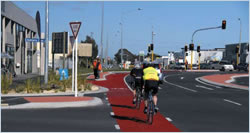The NZTA's Investment and Revenue Strategy (IRS) communicates the NZTA Board's investment intentions. It's a high-level direction-setting and prioritisation tool that helps the NZTA to balance competing priorities and select the best possible mix of activities for funding - all with the goal of advancing progress against the objectives of the Land Transport Management Act 2003 (LTMA) and the Government policy statement on land transport funding 2009/19 - 2018/19 (GPS)(external link).
The Investment and Revenue Strategy aims to ensure that the NLTP gives effect to the GPS in the short to medium term and, in the long term, that the NZTA's investment decisions and business priorities are aligned with the outcomes and impacts specified in:
The GPS is the government's statement that sets the strategic direction for investment in the land transport sector and provides funding ranges for individual 'activity classes'. The NZTA's role is to decide on the specific activities and combinations of activities in which to invest.
The GPS specifies a number of impacts that the government expects to achieve through the NLTP. These are:
Given the GPS's requirement that the NZTA focus on activities that make the greatest contribution to New Zealand's economic growth and productivity, this NLTP prioritises activities that make the most significant contribution to one or more of:
The priority given to RoNS, key freight and tourism routes, key urban arterials and model urban walking and cycling communities is new for the NZTA. Strategic plans are being developed for each of these areas and are due to be finalised by December 2009. They will provide the NZTA and those seeking NLTP funding approval with clear guidance on what will be prioritised and why. In the meantime, interim guidelines are in place.
In all its investments, the NZTA maintains its longstanding focus on activities that make a significant contribution to one or more of:
It's important to note that safety, particularly reducing the number of deaths and serious injuries as a result of road crashes, has always been and remains a core NZTA priority.
¹ Model communities aim to reduce congestion by providing user-friendly environments for walking and cycling

When approving funding for particular transport activities or groups of activities, the NZTA is required to ensure that they:
The NZTA uses three key assessment criteria to determine whether a transport activity will be included in the NLTP and, if so, the degree to which it will be prioritised within the NLTP, and then whether it will be approved for funding. The criteria are:
Note the 'strategic fit' criterion is new to this NLTP, developed in response to the GPS. It replaces the 'seriousness and urgency' criterion used in previous NLTPs.
The prioritisation process gives the greatest weight to 'strategic fit', followed by 'economic efficiency' and 'effectiveness'. Each activity is given a rating of high, medium or low according to these criteria.
'Strategic fit' ensures that the activities the NZTA approves for funding address significant opportunities and issues from a national perspective.
In assessing a transport activity for strategic fit, the NZTA considers how well it aligns with the Investment and Revenue Strategy's investment direction.
The 'effectiveness' assessment is about a proposed investment's contribution to:
Higher ratings go to proposals that provide long-term, integrated and enduring solutions.
'Economic efficiency' assessments apply to activities that deliver transport infrastructure or services. They identify how efficiently resources are used, how sustainable the benefits are, and whether the proposal represents value for money.
The NZTA assesses economic efficiency according to:
In developing the activities detailed in this NLTP, the NZTA has endeavoured to make the best use of the government's $8.7 billion, three-year investment in New Zealand's transport infrastructure and services.
Longer term, the primary focus for state highways will continue to be roads of national significance. In addition, the future investment direction for local roads and state highways will be influenced by regional and local planning, the Road Safety to 2020 Strategy and progress towards a more consistent and national approach to road maintenance standards.
For public transport services the future challenge is to improve the effectiveness of all the services in delivering value for money. In this regard, the NZTA will be implementing with its regional partners the new procurement procedures, develop a framework for fare box policies for all services, and explore ways in which integrated ticketing can be used to improve services and reduce costs.
The priority for 2009/12 and beyond for walking and cycling activities is to improve the contribution these activities make to the reduction of congestion in the main urban areas. This will be done by targeting investment at communities that have long-term commitment to significantly increasing walking and cycling as a practical and safe travel option.
And finally looking ahead for road policing funding, the main influence on the direction for this activity class will be the Road Safety to 2020 Strategy and broader discussions around what the most appropriate and effective roles of all the various agencies are.
The NZTA is committed to working closely with regional and local authorities, New Zealand Police and other land transport partners to manage the investment in all land transport activities and ensure a consistent and continual approach to meeting the objectives the government seeks.
This NLTP delivers a programme of well targeted investments in quality infrastructure and services that will benefit all New Zealanders. Implemented in the next three years, it will provide long-term benefits for both the transport network and the nation's social and economic development.
Last updated: 6 October 2009